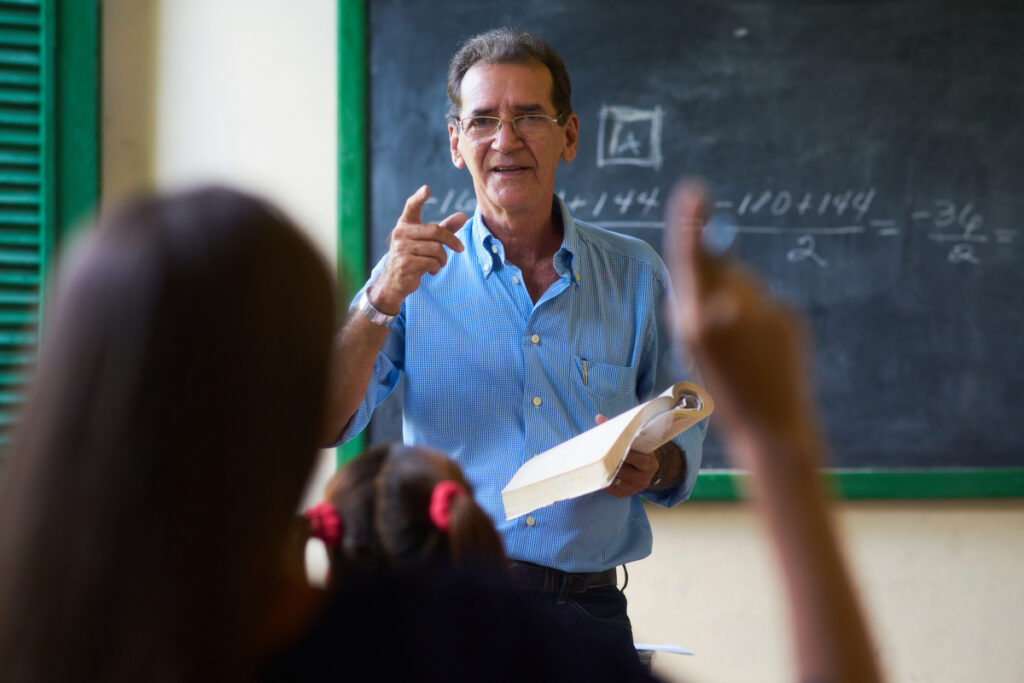If school brings to mind one teacher for a classroom of students, you should think again. Today’s educational goals call for collaboration among teachers. According to the National Education Association, the best way to improve education is for teachers to work together; they can share ideas and resources, brainstorming to find solutions. Including parents in collaboration and working with them to strengthen educational efforts will create a better learning environment for students. Encouraging students to learn collaboratively takes the idea even further, helping students develop communication skills, and learning from each other and their teacher. In workplaces around the world, collaboration and team-building are prized skills among employees. Collaboration and cooperation should begin in the classroom among students as part of the learning process.

Teachers should model the way they work together and teach students. This article will look at best practices for collaboration in the classroom, how collaboration works, and why collaboration teaching should be the future of education. We’ll answer the question, “Why is collaboration important in education?” and we’ll look at collaboration strategies for teachers that are proven effective. How teachers and students communicate within a collaborative setting will be examined as part of how collaboration works. We’ll also discuss the space where they will collaborate and whether their collaboration will be assisted through technology. Finally, in this story, we’ll examine the collaboration of teams to find ways that the group can achieve far more through collaborative efforts than they could individually.
Why is Collaboration Important in Education?
Collaboration among teachers and collaborative learning are important in education because of the professional development and peer support they bring to educators and the success and communication skills they provide to students. Collaboration is one of the most powerful philosophies in today’s classrooms and will be an essential part of education in the future. The concept of teachers working together to solve problems and of breaking students into small groups to work on projects and learn from each other isn’t new. George Washington University reports that research into collaborative learning was done in the 1980s and 1990s, a time when traditional models featuring individual work were prevalent. In the decades since, the world has changed. Technology has expanded the capabilities of collaboration, and workplaces have come to expect their employees to build teams and work together to solve problems and reach goals. To teach today’s students the key skills of collaboration and teamwork that they’ll need to succeed in tomorrow’s workforce, teachers will need to model collaborative learning and bring best practices found through cooperation and communication. By working together, sharing ideas, and listening to each other, teachers can find the best ways to educate their students. When educators model best practices of communication, cooperation, and listening, they are helping their students develop those essential skills. Whether it’s among teachers or students, collaboration works as an educational strategy. When people collaborate and listen to each other’s ideas, they learn from each other. Through collaboration, everyone will succeed.
“It is literally true that you can succeed best and quickest by helping others to succeed.”
Napoleon Hill
Collaboration Strategies for Teachers
Creating organizational models to facilitate collaboration among teachers and collaboration teaching doesn’t mean automatic success in the classroom. How teachers engage in collaboration teaching is a greater determinant of success. If teachers enter into collaboration with a positive mindset, collaboration teaching has a much greater chance of success than if they consider it as something they’re being forced to do. To nurture and encourage collaboration among teaching colleagues, the Association for Middle-Level Education recommends collaboration strategies for teachers. These methods include having a shared vision and goals, developing a sense of community among colleagues, creating a climate of trust, allowing discussion and dialogue to move the collaborative process forward and work through conflict. By creating trust and rules for effective communication and conflict resolution, collaboration among educators can grow stronger within a framework of respect and honesty. When educators help create the vision and goals for their collaboration, they are invested in the success of the cooperative project. This will ensure that educators believe in the results of their collaboration. By developing plans for collaboration teaching together, teachers will create a sense of camaraderie and community among their team. Technology can help in creating a climate of communication and trust that can bridge distances, but care should be taken to make sure that meetings, whether in person or virtual, are at times that are convenient for everyone. Once the group begins to see success, collaboration teaching methods are reinforced, making success in future collaboration likely. Progress, respect, and honest communication will ensure that collaboration works.
Collaboration of Teams
The purpose of collaboration is to share ideas. When communication happens in an atmosphere of trust and respect, it is likely to be productive communication. Conflicts may arise during collaboration, and they should be addressed. Teams can manage conflict by allowing members to work through disagreements. Team facilitators should use their judgment in deciding if the team needs a break to reflect and for tempers to cool. Exploring the roots of conflicts can help collaboration and trust grow.

Collaboration teaching and cooperative methods of learning and communication develop as a culture. While collaboration can be a complex process, collaboration works well as a method of learning from fellow educators, sharing tips for success as well as advice for avoiding mistakes. Making sure that time is dedicated for team meetings, professional development, and planning time during the school day will encourage professional growth among educators that will translate to student achievement. Over time, teachers will develop a culture of honest communication and collaboration. They’ll prioritize time dedicated to addressing classroom issues and shared objectives, advancing their skills in communication, listening, and education. When teachers experience success in collaboration, they will likely share these techniques with the students in their classrooms. Collaborative learning in classrooms fosters better communication skills among students as they learn from each other, letting the next generation see for themselves how well collaboration works. Learning both through practice and from example will be instrumental in the future success of students.
